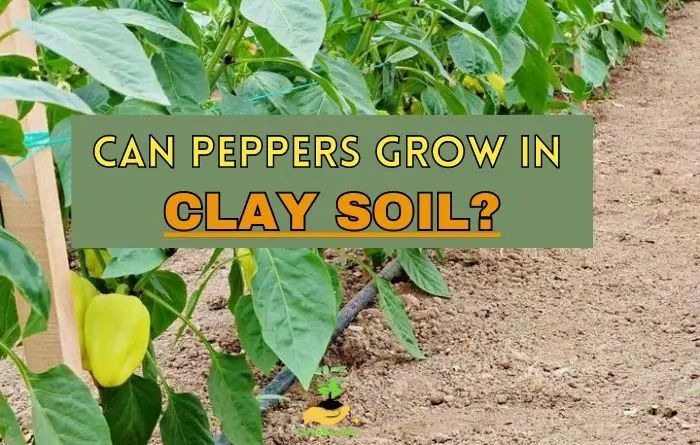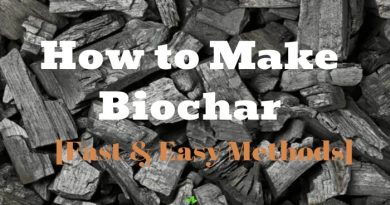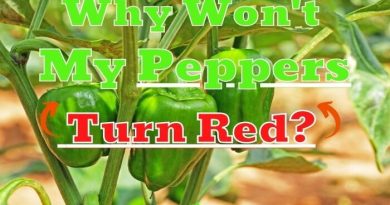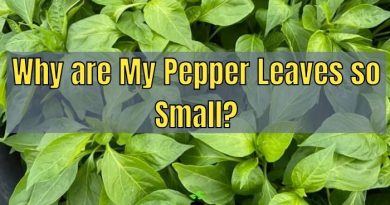Can Peppers Grow in Clay Soil? Expert Answer Here!
If you’re an avid gardener like me, you may be wondering if you can grow peppers in clay soil. Clay soil is known for being heavy and dense, which can make it difficult for plants to thrive. However, with the right techniques and care, it is possible to grow peppers in clay soil.
Can Peppers Grow in Clay Soil?
Peppers usually prefer loamy soil, but they can still grow in clay soil with some adjustments and care. To make clay soil more suitable for growing peppers, organic matter can be added to reduce its density and improve drainage. While clay soil can affect the amount of water that peppers receive, it is possible to grow peppers in clay soil if the right amendments are made. So, while peppers thrive best in loamy soil, they can still tolerate clay soil with some modifications.
Table: Pepper Varieties known to perform well in clay soil conditions
| Pepper Variety | Description | Adaptability to Clay Soil |
|---|---|---|
| Bell Pepper ‘Ace’ | A popular choice for its large, sweet fruits and high yields. Suitable for clay soil due to its strong root system and ability to tolerate less-than-ideal conditions. | Performs well in clay soil with proper soil preparation and adequate drainage. |
| Jalapeno ‘Early Jalapeno’ | Known for its spicy kick and versatility in the kitchen, Early Jalapeno is a hardy pepper variety that can tolerate clay soil. Its compact size makes it suitable for container gardening in clay soil as well. | Demonstrates adaptability to clay soil with proper care and attention to watering needs. |
| Banana Pepper ‘Sweet Banana’ | A mild and tangy pepper variety that thrives in clay soil. Sweet Banana peppers have a unique shape and are great for pickling, stuffing, or enjoying fresh. | Exhibits good adaptability to clay soil, particularly if proper soil amendments are applied. |
| Poblano Pepper ‘Ancho’ | A flavorful pepper often used in Mexican cuisine, the Ancho pepper has thick, meaty flesh. It can withstand clay soil conditions and is renowned for its rich, smoky flavor. | Shows good tolerance to clay soil, but may benefit from raised beds or well-draining soil amendments. |
| Cayenne Pepper ‘Long Slim’ | A popular variety of hot pepper, the Cayenne Long Slim is a prolific grower that can tolerate clay soil. It is ideal for drying and grinding into homemade spice blends. | Performs well in clay soil with proper care and watering practices. |
| Sweet Pepper ‘Gypsy’ | A crisp and flavorful sweet pepper that is tolerant of clay soil conditions. With its compact, bushy growth habit, it can be grown successfully both in-ground or in containers. | Exhibits good adaptability to clay soil, particularly if provided with adequate drainage and organic matter. |
https://www.rhs.org.uk/soil-composts-mulches/soil-types
Note: According to my research, these pepper varieties have been observed to perform well in clay soil conditions. However, it is important to note that individual gardeners’ experiences may vary based on their specific soil composition, climate, and gardening practices. Proper soil preparation, regular watering, and incorporating organic matter can further enhance the success of growing peppers in clay soil.
Challenges of Growing Peppers in Clay Soil
Growing peppers in clay soil can be challenging due to several factors. Here are some of the challenges you may face:
Poor Drainage
Clay soil presents a challenge due to its limited drainage capacity, which can result in waterlogging and root rot. The excessive moisture restricts root function, impeding nutrient absorption and hampering plant growth, ultimately leading to subpar yields.
To enhance drainage in clay soil, incorporating organic matter like compost or well-rotted manure proves beneficial. This practice facilitates the breakdown of clay particles and the formation of pore spaces, enabling water to drain away more effectively.
Moisture Retention
Clay soil presents a dual challenge, as it can be excessively wet or excessively dry. Its high moisture retention capacity causes water to linger in the soil for extended periods, potentially leading to difficulties during hot and dry spells.
In such conditions, the soil can become hardened and parched, impeding the absorption of water and nutrients by the roots. To address this issue, applying mulch to the soil surface proves beneficial.
Mulch aids in moisture retention, preserving adequate soil moisture levels and preventing excessive evaporation. Additionally, it helps maintain a cooler soil temperature, creating a more favorable environment for root development and nutrient uptake.
Compaction
Clay soil has a tendency to become compacted, creating obstacles for root penetration and nutrient accessibility. Compaction also diminishes pore spaces within the soil, resulting in inadequate drainage and potential waterlogging.
To prevent compaction-related issues, it is advisable to avoid from walking on the soil when it is wet. Additionally, employing raised beds or containers for pepper cultivation can mitigate the impact of compaction, providing an environment that promotes healthy root growth and optimal nutrient uptake.
Nutrient-Rich
While clay soil is known for its nutrient-rich composition, accessing those nutrients can be challenging for plants. The clay particles tend to bind with the nutrients, rendering them unavailable for plant uptake.
To enhance nutrient availability, incorporating organic matter like compost or well-rotted manure into the soil proves beneficial. This practice aids in the breakdown of clay particles, freeing up the nutrients and making them more accessible to plants.
By amending the soil with organic matter, you create a more favorable environment for nutrient absorption and overall plant growth.
In summary, growing peppers in clay soil can be challenging due to poor drainage, moisture retention, compaction, and nutrient availability. However, with the right techniques and care, it is possible to grow healthy and productive pepper plants in clay soil.
How to Grow Peppers in Clay Soil
To successfully grow peppers in clay soil, follow this step-by-step guide:
- Soil Preparation:
- Enhance drainage by incorporating organic matter like compost, well-rotted manure, or peat moss. This improves soil structure and breaks up compacted clay.
- Further improve drainage by adding coarse sand at a ratio of approximately 1 part sand to 3 parts soil.
- Raised Beds or Mounds:
- Consider creating raised beds or mounds, which improve drainage and create a more favorable growing environment for peppers.
- Build raised beds using a mixture of topsoil, compost, and sand to enhance the growing conditions.
- Site Selection:
- Choose a location with full sun exposure, providing at least 6-8 hours of direct sunlight daily.
- Avoid low-lying areas that tend to retain excess moisture and exacerbate drainage issues.
- Planting:
- Wait until after the last frost date and ensure the soil has warmed up before planting peppers.
- Dig holes slightly larger than the root balls of the pepper plants.
- Place your pepper plants in the holes and backfill with a mixture of the amended clay soil and organic matter.
- Watering:
- Water deeply, allowing the water to penetrate the soil and encourage deep root development.
- Avoid overwatering, as clay soil retains moisture for longer periods. Allow the top few inches of soil to dry out between waterings to prevent waterlogging.
- Mulching:
- Apply organic mulch around the base of the pepper plants to regulate soil temperature, conserve moisture, and inhibit weed growth.
- Fertilization:
- Prior to planting, apply a balanced fertilizer following the recommended rates on the package.
- Throughout the growing season, continue fertilizing as needed based on soil test results or signs of nutrient deficiencies.
- Pest and Disease Management:
- Regularly monitor the pepper plants for pests and diseases.
- Utilize organic or chemical controls when necessary.
- Promptly remove any affected leaves or fruit to prevent the spread of diseases.
By following these guidelines, you can successfully grow peppers in clay soil and increase your chances of a productive harvest.
Conclusion
In conclusion, peppers can grow in clay soil, but it may require additional effort and care. Clay soil is known for its poor drainage and compactness, which can make it difficult for plants to thrive. However, with proper preparation and maintenance, you can successfully grow peppers in clay soil.
To ensure the best results, consider adding organic matter such as compost or well-rotted manure to your clay soil before planting. This will help improve soil structure and drainage, allowing your peppers to grow healthy roots and access essential nutrients.
Frequently Asked Questions
Amending clay soil for peppers requires adding organic matter like compost or shredded leaves. Mix 1-2 inches of organic matter into the top 6-12 inches of soil. By doing so, it’ll add nutrients, improve drainage, and soil structure, helping peppers to grow better and produce a healthy yield of peppers.
Peppers growing in clay soil will need watering when the soil around the plant is dry. Clay soil can hold onto moisture and be slow to drain away, so make sure you don’t overwater, as this can lead to root rot. A good rule of thumb is to water moderately when the soil is dry to touch.
Yes, raised beds can be an ideal solution to grow peppers in clay soil. Good quality potting soil composed of organic matter, sand, and perlite, added to the raised beds, will help protect the plants against diseases, weeds, and general soil-related problems. It will also allow you to control your soil’s pH and nutrient content appropriately.




